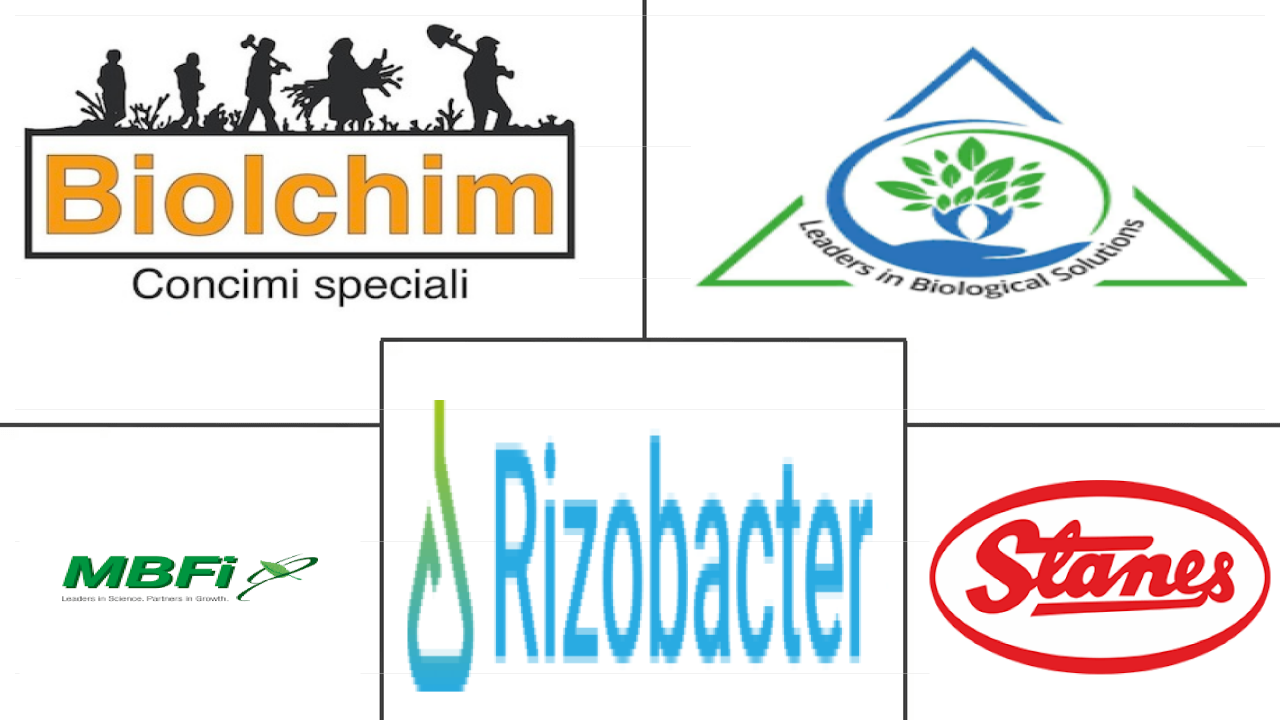Market Size of africa biofertilizer Industry
| Icons | Lable | Value |
|---|---|---|
|
|
Study Period | 2017 - 2029 |
|
|
Market Size (2024) | USD 226.59 Million |
|
|
Market Size (2029) | USD 354.28 Million |
|
|
Largest Share by Form | Rhizobium |
|
|
CAGR (2024 - 2029) | 9.35 % |
|
|
Largest Share by Country | Egypt |
|
|
Market Concentration | Low |
Major Players |
||

|
||
|
*Disclaimer: Major Players sorted in no particular order |
Africa Biofertilizer Market Analysis
The Africa Biofertilizer Market size is estimated at 226.59 million USD in 2024, and is expected to reach 354.28 million USD by 2029, growing at a CAGR of 9.35% during the forecast period (2024-2029).
226.59 Million
Market Size in 2024 (USD)
354.28 Million
Market Size in 2029 (USD)
5.02 %
CAGR (2017-2023)
9.35 %
CAGR (2024-2029)
Largest by Form
45.72 %
value share, Rhizobium, 2023
Rhizobium is a soil bacteria that aids leguminous plants in nitrogen fixation, potentially replacing commercial N fertilizers. Rhizobium increases agricultural productivity.
Fastest by Form
9.59 %
Projected CAGR, Rhizobium, 2024-2029
Rhizobium is mostly used for leguminous crops and can enhance output by 25 to 35% while reducing the overall chemical fertilizer requirement by 20 to 25% in some crops.
Largest by Crop Type
76.43 %
value share, Row Crops, 2023
Corn, wheat, rice, and legumes are among the major row crops grown in the region. Rhizobium application dominates the row crop with 45.7% of the market value in 2022.
Largest by Country
4.36 %
value share, Egypt, 2023
Egypt's major crops include rice, wheat, maize, cotton, and fruits and vegetables. Rhizobium is dominant in the country, they accounted for 39.1% of the market value in 2022.
Leading Market Player
1.54 %
market share, Rizobacter, 2022

The company provides biofertilizers for plant growth that are based on natural nutrition provided by selected microorganisms that are already present in the soil.
- Biofertilizers are living microorganisms that improve plant nutrition by mobilizing or increasing nutrient availability in soils. Mycorrhiza, Azospirillum, Azotobacter, Rhizobium, and phosphate-solubilizing bacteria are the most frequent microorganisms used as biofertilizers in agriculture.
- Among these biofertilizers, Rhizobium is most widely used in Africa, accounting for 45.6% of the market in 2022 and valued at USD 87.5 million. Rhizobium is the most prominent nitrogen-fixing bacteria that live in the root nodules of leguminous plants and has a symbiotic relationship with plants.
- Azospirillum accounted for the second-largest market share, valued at USD 43.8 million in 2022. Azospirillum-based biofertilizers promote plant vegetative growth by substituting 25-30% of plant nitrogen requirements.
- Row crops dominated the biofertilizer market, valued at about USD 146.8 million and accounting for 76.5% of the consumption share in 2022, followed by horticultural crops, valued at USD 30.5 million. The market value of biofertilizers in row crops is constantly expanding. It increased by about 17.8% between 2017 and 2021. It is anticipated to increase by about 69.6% by the end of the forecast period, reaching USD 270.0 million.
- The application of biofertilizers can reduce the use of chemical nitrogen fertilizers and the overall cost of cultivation. The demand for organic products in domestic and international markets is increasing, thus driving the demand for biofertilizers in the region.
- As the demand for organically cultivated food grows in many African countries such as Egypt, Nigeria, and South Africa, Africa is a significant market for biofertilizers. During the historical period (2017-2022), the region's organically cultivated area expanded slightly, from 1.1 million hectares in 2017 to 1.3 million hectares in 2022. During the same period, the African biofertilizer market grew by 6.9%. Majorly cereal crops are produced in the region, like maize, wheat, and corn.
- Rhizobium is the most often used biofertilizer in African countries, accounting for 45.6% of the market in 2022 and worth USD 87.5 million. Rhizobium is the most prominent nitrogen-fixing bacterium that resides in the root nodules of leguminous plants and has a symbiotic connection with plants.
- In the Rest of Africa, in terms of area, Tunisia was the region's largest organic producer in 2021. Around 60 of the 250 organic product categories cultivated in Tunisia are exported, mostly olive oil, but also dates, aromatic and medicinal herbs, and certain vegetables and fruits. Tunisia ranks 30th in the world and first in Africa in terms of organic farming area certification, despite its small size.
- The major countries and regions with organic agricultural acreage include the Rest of Africa, Egypt, and South Africa. In 2022, the Rest of Africa accounted for 95.0% of total organic agricultural acreage in Africa, with 1.2 million hectares. In the same year, Egypt accounted for 3.5%, with 45.1 thousand hectares, and South Africa accounted for 1.0%. with 12.6 thousand hectares.
- The demand for biofertilizers is expected to rise during the forecast period owing to rising consumer interest in organic products. Farmers are becoming more aware of the disadvantages of relying on chemical inputs in agriculture and increasing organic acreage, which may also drive the market.
Africa Biofertilizer Industry Segmentation
Azospirillum, Azotobacter, Mycorrhiza, Phosphate Solubilizing Bacteria, Rhizobium are covered as segments by Form. Cash Crops, Horticultural Crops, Row Crops are covered as segments by Crop Type. Egypt, Nigeria, South Africa are covered as segments by Country.
- Biofertilizers are living microorganisms that improve plant nutrition by mobilizing or increasing nutrient availability in soils. Mycorrhiza, Azospirillum, Azotobacter, Rhizobium, and phosphate-solubilizing bacteria are the most frequent microorganisms used as biofertilizers in agriculture.
- Among these biofertilizers, Rhizobium is most widely used in Africa, accounting for 45.6% of the market in 2022 and valued at USD 87.5 million. Rhizobium is the most prominent nitrogen-fixing bacteria that live in the root nodules of leguminous plants and has a symbiotic relationship with plants.
- Azospirillum accounted for the second-largest market share, valued at USD 43.8 million in 2022. Azospirillum-based biofertilizers promote plant vegetative growth by substituting 25-30% of plant nitrogen requirements.
- Row crops dominated the biofertilizer market, valued at about USD 146.8 million and accounting for 76.5% of the consumption share in 2022, followed by horticultural crops, valued at USD 30.5 million. The market value of biofertilizers in row crops is constantly expanding. It increased by about 17.8% between 2017 and 2021. It is anticipated to increase by about 69.6% by the end of the forecast period, reaching USD 270.0 million.
- The application of biofertilizers can reduce the use of chemical nitrogen fertilizers and the overall cost of cultivation. The demand for organic products in domestic and international markets is increasing, thus driving the demand for biofertilizers in the region.
| Form | |
| Azospirillum | |
| Azotobacter | |
| Mycorrhiza | |
| Phosphate Solubilizing Bacteria | |
| Rhizobium | |
| Other Biofertilizers |
| Crop Type | |
| Cash Crops | |
| Horticultural Crops | |
| Row Crops |
| Country | |
| Egypt | |
| Nigeria | |
| South Africa | |
| Rest of Africa |
Africa Biofertilizer Market Size Summary
The Africa biofertilizer market is experiencing significant growth, driven by the increasing demand for organic products and the need to reduce chemical fertilizer usage. Biofertilizers, which are living microorganisms that enhance plant nutrition by improving nutrient availability in soils, are becoming increasingly popular in the region. Key microorganisms used in this market include Rhizobium, Azospirillum, Azotobacter, and phosphate-solubilizing bacteria. Rhizobium, in particular, is the most widely used biofertilizer in Africa due to its symbiotic relationship with leguminous plants, making it a crucial component of the market. The market is predominantly driven by the cultivation of row crops, which hold a significant share of the biofertilizer consumption, followed by horticultural crops. The growing awareness among farmers about the benefits of organic farming and the reduction of chemical inputs is further propelling the market's expansion.
The demand for biofertilizers in Africa is also supported by the region's increasing organic agricultural acreage, with countries like Egypt, Nigeria, and South Africa leading the charge. The rise in per capita income and the shift towards organic food consumption are contributing to the market's growth. Despite the challenges posed by low-income levels and the lack of organic standards, the market is witnessing a surge in interest from both certified and uncertified organic farmers. The fragmented nature of the market, with major players like Biolchim SPA, IPL Biologicals Limited, and Rizobacter, is indicative of the competitive landscape. Collaborations and innovations in soil and crop nutrition technologies are expected to enhance the product offerings, further driving the market's growth during the forecast period.
Africa Biofertilizer Market Size - Table of Contents
-
1. MARKET SEGMENTATION (includes market size in Value in USD and Volume, Forecasts up to 2029 and analysis of growth prospects)
-
1.1 Form
-
1.1.1 Azospirillum
-
1.1.2 Azotobacter
-
1.1.3 Mycorrhiza
-
1.1.4 Phosphate Solubilizing Bacteria
-
1.1.5 Rhizobium
-
1.1.6 Other Biofertilizers
-
-
1.2 Crop Type
-
1.2.1 Cash Crops
-
1.2.2 Horticultural Crops
-
1.2.3 Row Crops
-
-
1.3 Country
-
1.3.1 Egypt
-
1.3.2 Nigeria
-
1.3.3 South Africa
-
1.3.4 Rest of Africa
-
-
Africa Biofertilizer Market Size FAQs
How big is the Africa Biofertilizer Market?
The Africa Biofertilizer Market size is expected to reach USD 226.59 million in 2024 and grow at a CAGR of 9.35% to reach USD 354.28 million by 2029.
What is the current Africa Biofertilizer Market size?
In 2024, the Africa Biofertilizer Market size is expected to reach USD 226.59 million.

